You are currently browsing the final countdown category
And here we are, at long last, with the final part of the ’80s Countdown, where I tallied up your votes for your favorite 1980s indie book and presented the winners, in ascending order, over a particularly extended period of time. But we’ve reached the conclusion, with the top vote getter, including my own vote, and it should be no surprise which title it is.
Love and Rockets (Fantagraphics 1982-1996)
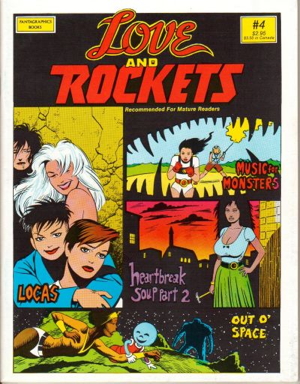 For over forty years, the Hernandez Brothers (Jaime, Gilbert, and occasionally Mario) have been gifting the comics world with some of the best cartooning and most realized worlds and characters to have ever graced the medium. It’s hard to believe it’s been that long, as you look at the work being produced and you can see no decline, no lessening of their powers — only an ever-continuing evolution and refinement of their craft. The stories remain as entertaining and compelling as they ever were, the artwork perfectly expressive. Every new comic from them is a master class in How To Do Comics and we are lucky to get them.
For over forty years, the Hernandez Brothers (Jaime, Gilbert, and occasionally Mario) have been gifting the comics world with some of the best cartooning and most realized worlds and characters to have ever graced the medium. It’s hard to believe it’s been that long, as you look at the work being produced and you can see no decline, no lessening of their powers — only an ever-continuing evolution and refinement of their craft. The stories remain as entertaining and compelling as they ever were, the artwork perfectly expressive. Every new comic from them is a master class in How To Do Comics and we are lucky to get them.
Did I oversell it yet? Honestly, I don’t think I have.
Reams have been written on Love and Rockets and its ancillary works and I’m honestly not sure what else I can add to it. I can say this series has special meaning to me, in that the brothers hail from Oxnard, CA, as do I, and I can often recognize references to the area in their works. Especially when they just straight up put my previous place of employment in the background:
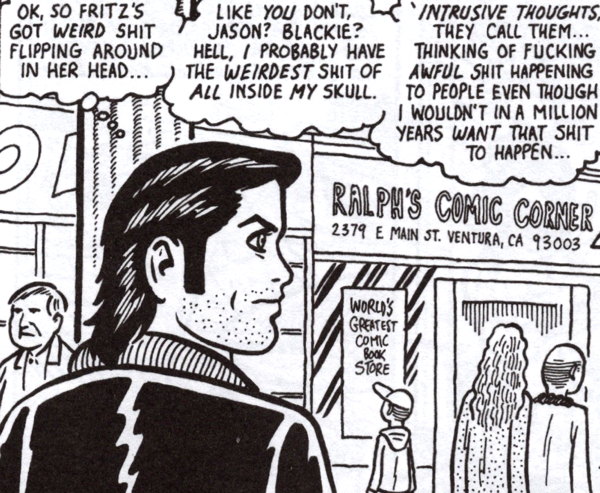
In full disclosure, I should mention that I’ve known the brothers for…well, about as long as I’ve been in the comics business, currently 35 years and counting. They were already friends with my former boss, Ralph, when I started working for him…they had even helped move his store when he upgraded from one tiny hole-in-the-wall to a slightly larger hole-in-the-wall. Ralph was, in fact, the first comics retailer to carry their original self-published version of Love and Rockets #1 (often referred to as the “black and white” edition), which I will show you here scanned from my own personal collection, he bragged:
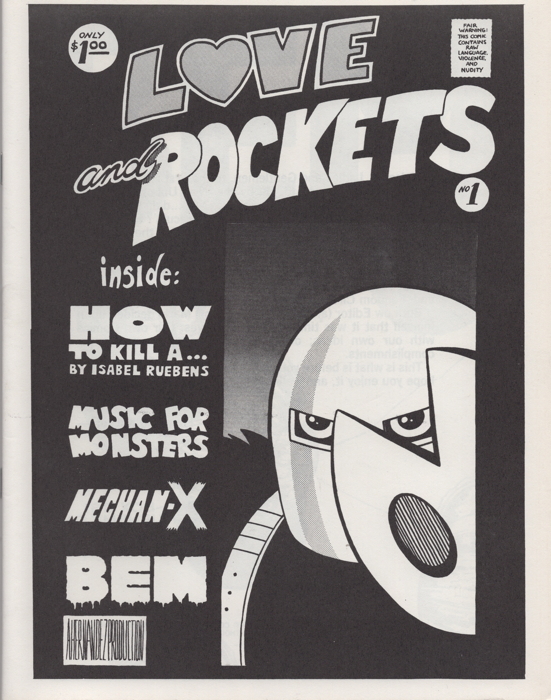
But before I met them in person, I was already a fan. I kinda knew Jaime and Gilbert’s work already, in that their art would adorn stickers and fliers for various local punk rock bands…somewhere I think I still have a sticker or two by Jaime from ye olden tymes. But getting a whole magazine filled with their work…well, that was pretty great. And coincided with my specific attraction at the time to independently-produced comics outside the worlds of Marvel and DC. Not that I didn’t still love reading those, but getting to read different, “weird,” and personal comics scratched an itch that the four-color super books didn’t.
And Jaime and Gilbert (and sometimes Mario, who once drew my old boss Ralph into an issue!) have continued to scratch that itch over the decades, with ever-wonderful and innovative work. Jaime’s stories generally focus on the inhabitants of Hoppers 13 (essentially Oxnard), primarily Maggie and Hopey and their assorted friends, enemies, and frenemies. Gilbert’s focus is mostly on the Latin America town of Palomar, a generational saga based around Luba and her family, plus other inhabitants. Which isn’t to say there aren’t other unrelated stories and gags that appear during the run, but those are the biggies. And following these comics for forty years, watching the characters age and change, is a rare and rewarding experience in comics.
There have been five iterations of Love and Rockets over the years, starting with the self-published issue I scanned above. This was followed by the 50 issue run published by Fantagraphics from ’82 to ’96, which then published a twenty issue run in a standard comic book format (as opposed to the previous magazine-sized issues) from 2001 to 2007. This was followed by Love and Rockets: New Stories, publishing eight annual issues from 2008 to 2016 as squarebound graphic novels. Then Love and Rockets returned in 2016 in its original magazine format, and continues publication to this day.
Amongst those various L&Rs, Jaime and Gilbert released many minis and one-shots that, mostly, to various degrees, tied into their ongoing sagas. Of note was Gilbert’s Luba’s Comics and Stories (running eight issues from 2000-2006), Penny Century by Jaime (seven issues, 1997-2000), and Whoa, Nellie! also by Jaime (three issues in 1996).
The comics are usually in black and white, but there are been the rare color editions, such as the Mechanics mini in 1985, mostly reprinting some of aime’s work from the earlier issues with some new material. There was also the Maggie and Hopey Color Special in 1997, with new material by Jaime.
Gilbert has produced, and is still producing, several standalone graphic novels, tangentially related to the L&R Universe, featuring the character Fritzi in her various movies. Proof That The Devil Loves You is probably a good place to start with these.
And just so we’re clear, this doesn’t even cover all of the L&R material that has been put into the world. Usually in this series of posts I like to list the various reprintings of the comics being discussed, but boy howdy are there a lot of options here. A brief glace at the Fantagraphics catalog gives you an idea of what’s available. There are paperbacks devoted to either Jaime or Gilbert, reprinting their stories from the magazines and comics. Some comics have been reformatted into standalone graphic novels. For the adventurous among you, you can get the collection of the first fifty issues.
At any rate, there’s a lot of material here, and it’s hard to tell you where to start, other than “the beginning,” so maybe that “first 50” collection isn’t such a bad idea after all. But aside from just jumping onto the newest issue and hoping for the best, I’d probably recommend the collection Heartbreak Soup for Gilbert, and “The Death of Speedy” by Jaime (reprinted here). I mean, those are the obvious ones, but any given issue of the current series would probably give you an idea if these comics are for you. And I certainly hope they are, because they’re great.
• • •
And here we are, finally at the end of this series of posts that took, oh, only about ten months to finish. It was fun, though, looking back at all these indies and seeing what you folks liked and reminding myself of why
I liked many of them. Thanks for participating in the poll, and…will I do another poll like this for
1990s indies? I don’t know, let me recover from this one first!
Here we are, at the next-to-last entry in the Final ’80s Countdown, as voted by YOU! And me, but the one I voted for will be the next and final entry in this series. However, I would have voted for many of the comics I’ve covered here, and this one was really, really close….
Zot! (Eclipse Comics 1984-1991)
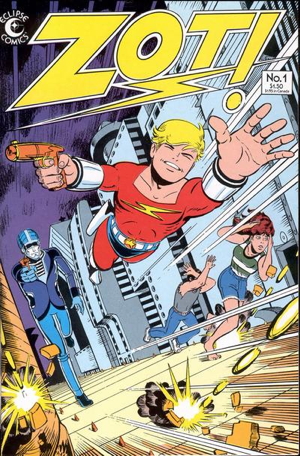 Well, this will be a tricky entry since I spent a couple or three posts talking about Scott McCloud’s Zot! about a year ago. (Note: the third post mentioned that a fourth post was coming, regarding something I found in a Zot! letters page…and then I got distracted and didn’t cover that topic back then, and I can’t remember now what I found! So I’ll have to peruse my Zot!s and see if I can’t remind myself for yet another future post!)
Well, this will be a tricky entry since I spent a couple or three posts talking about Scott McCloud’s Zot! about a year ago. (Note: the third post mentioned that a fourth post was coming, regarding something I found in a Zot! letters page…and then I got distracted and didn’t cover that topic back then, and I can’t remember now what I found! So I’ll have to peruse my Zot!s and see if I can’t remind myself for yet another future post!)
Anyway, there’s probably going to be some minor duplication of information here, but I’ll see what I can do. For the uninitiated, Zot! is about a young lady in our world named Jenny, who is surprised by a teen gentleman in gravity boots who flies through a portal from his world. His world, by the way, is Earth of the far-flung future of 1965 (Jenny’s, our, Earth being in 1984 at the time). Zachary T. Paleozogt, AKA Zot, is a young hero of his near-utopian Buck Rogers-esque Earth, with its advanced science and space travel and other technological marvels…not to mention the occasional villain!
Jenny of course prefers Zot’s magical world to her own “real” imperfect world of crime and misery an’ such, and spends a lot of time there with Zot and his friends and family through most of the first half of the run (which had a year-and-a-half gap between issues 10 and 11). For the latter part of the series, Zot! has it’s run of “Earth Stories,” in which Zot is trapped on Jenny’s Earth and finds his optimistic point of view contrasted against the real world at large. This run of stories also focus on the various personalities and issues of Jenny’s friends, dealing sensitively with teen romance and homosexuality.
Notably, that aforementioned publishing gap resulted in a shift in presentation and tone for the series. The first ten issues were a generally light-hearted sci-fi adventure (though not without its serious emotional moments), all in color. Starting after the gap, with issue #11, the series goes entirely black and white, and the storytelling becomes more somber and introspective as well. Not that there isn’t still humor and adventure, but there’s a larger emphasis on the emotional worlds these characters inhabit, versus the two literal worlds that are the settings for these stories. Though as I cover in this post, some questions are raised (and never answered) about the actual nature of Zot’s Earth.
It should also be noted that there are a couple of special related issues published along the way, but not by McCloud! Between issue #10 and #11 was the nigh-infamous Zot! #10 1/2 by mini-comics genius Matt Feazell, as seen here scanned from my very own personal copy:
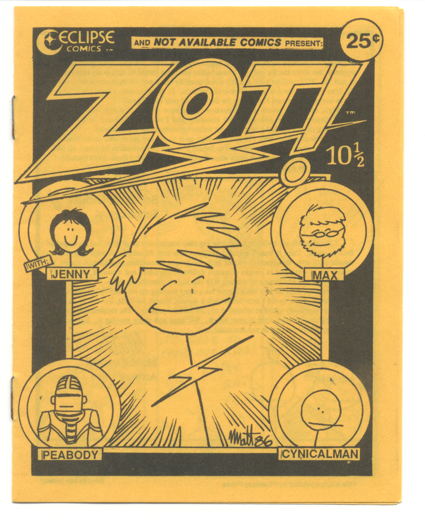
I’ve probably said here before (and told Mr. McCloud his own self) that this was the very first Zot! comic I’d ever read, and went back and bought the previous 10 before #11 came out.
In addition, there’s a Matt Feazell-created Adventures of Zot! #10 1/2 issue #14 1/2. And Feazell provides “10 1/2” Zot adventures as back-ups starting in #11.
The series eventually came to an end with #36, with the only follow-up being a webcomic McCloud created and serialized originally on a comic news/reviews site, and is now hosted at his own webpage. And that’s it for Zot!, a mostly self-contained story aside from those previously mentioned unanswered questions. It’s a wonderful piece of work, with beautiful cartooning supporting a story that mixes adventure, silliness, and real emotion in just the right proportions.
I covered in this post about the various reprints available for the series. You can check there (things haven’t changed since I wrote that), but in short: the black and white issues are mostly reprinted in a book called The Complete Black and White Collection which is currently available. Issues #19 and #20 are only represented by McCloud’s layouts, as the stories had been drawn by another artist.
The first ten color issues have appeared in an out-of-print single volume from the now-defunct Kitchen Sink, and may go for premium pricing. Feazell’s 10 1/2 mini-comic and issue #14 1/2 remain unreprinted to the best of my knowledge. It should be noted that single issues of the series are relatively inexpensive though it may take some tracking down. The Feazell issues may be a little harder to spot.
I feel like a Zot! omnibus collecting everything together would make for a handsome, if mildly cumbersome, package. At the very least, it would be nice to have the first 10 issues back in print as a necessary, I think, contrast to the back half of the series.
Zot! stands as one of the classic indies of the period, and well worth seeking out if you haven’t read it. McCloud may be more famous now for his Understanding Comics series of books, but I’ll always have a soft spot for Zot, Jenny, Butch, Dekko, 9-Jack-9, Woody, Terry, Uncle Max, and so many more.
Very near the end here…this is the third-from-last entry in this series covering your favorite 1980s indies from this poll of mine. This is the one that almost got my vote, and it remains a much-beloved series. So here we go:
Grimjack (First Comics 1984-1991)
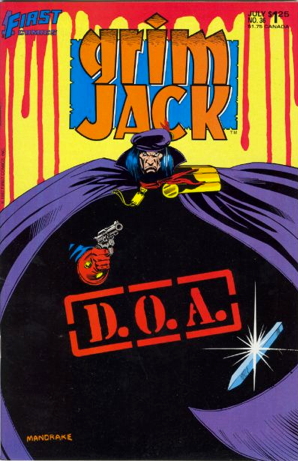 Grimjack, the soldier/detective/bounty-hunter/bodyguard/etc. for hire who operates in the multi-dimensional city of Cynosure, first appeared as a back-up story by creators John Ostrander and Tim Truman in Starslayer #10 in 1983. After a run of stories there (capping off with an issue-length crossover with the titular Starslayer his own self), Grimjack moved over to his own first issue in 1984, running 81 issues (and a graphic novel) through ’til 1991.
Grimjack, the soldier/detective/bounty-hunter/bodyguard/etc. for hire who operates in the multi-dimensional city of Cynosure, first appeared as a back-up story by creators John Ostrander and Tim Truman in Starslayer #10 in 1983. After a run of stories there (capping off with an issue-length crossover with the titular Starslayer his own self), Grimjack moved over to his own first issue in 1984, running 81 issues (and a graphic novel) through ’til 1991.
And it’s quite a ride. Grimjack (AKA John Gaunt) has been around a bit, seen a lot, fought in the Demon Wars, tough and grizzled but loyal to, and protective of, his friends. His base of operations is Munden’s Bar in Cynosure, and the bar itself is the setting for a well-regarded run of back-up stories in the series by a multitude of artists and the occasional guest stars (the Teenage Mutant Ninja Turtles appear in one story!).
Truman illustrated the early part of the run, followed primarily by the moody artwork of Tom Mandrake (and it’s Mandrake’s rendition that I primarily associate with the character, as it’s such a major chunk of the series). Following him is Flint Henry, who takes over after a particular change in direction which I’ll discuss in a moment.
Grimjack himself goes through some serious changes through the run [SPOILERS AHEAD], not least of which is just straight up gettin’ killed, going to the afterlife, and then returning to the land of the living via his soul inhabiting a younger clone of himself. Along the way Grimjack also encounters a man claiming to be a future version of himself, who has traveled back in time in an attempt to undo a curse he is — they are — under, that causes them to be reincarnated over and over again.
Anyway, everyone figures that’s crazy talk…until about 2/3rd into the series run there’s a time jump, and lo and behold, Grimjack is in the future, reincarnated as “James Twilley,” who picks up where he left off in the man-for-hire business with a (mostly) new cast of friends and enemies.
I wrote about a lot of this in 2009, including this excerpt from the last issue’s editorial page with its plans for future stories:
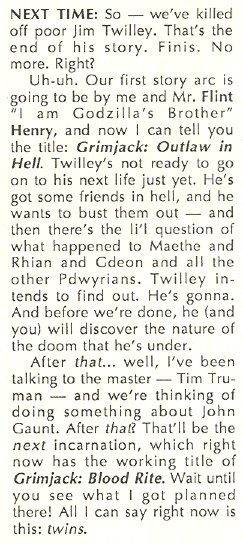
Anyway, none of that happened, and those dangling plotlines remain dangling. I was kind of looking forward to eventually reading the story of the Future Grimjack that appeared in the original Grimjack’s timeline, maybe seeing things from his perspective, but alas.
After the end of the original Grimack series, the returned in two new mini-series published by IDW in 2005 and 2009. However, these were set in the John Gaunt era and did not continue from where they left off. I should note they were still plenty enjoyable, reuniting Ostrander and Truman for a couple of quality adventures.
As I lamented back in 2009, we’re almost certainly not going to see the storyline advance past the Twilley era into any future incarnations. 30+ years on, trying to get any new readers on board and invested in that specific premise seems a lot harder than just doing back-to-basics Classic Jack stories that don’t require more explanation than “this is a tough guy people hire to do stuff.” I mean, maybe it can be done, but the image of Grimjack that survives is that Truman version. It just feels like it helps to be familiar with what came before, prior to starting to do wild variations on it. The former informs the latter, but if you don’t know the former, the latter lacks its impact.
I don’t know. If Ostrander were to announce “we’re picking up where we left off, just jump in and hang on” I’d be there in a heartbeat. If this supposed Grimjack movie or TV show or whatever it’s going to be now ever materializes, maaaaaybe there’d be enough interest to jumpstart the book and we can get goin’ again, but I’m not holding my breath.
If you want to catch up yourselves, you’re in luck as the series has been reprinted. There are five volumes of the Grimjack Omnibus, which reprint the First Comics run in its entirety, including the Demon Night graphic novel. These were from Comicmix, and they appear to be out of print, but should be easy enough to find, I’d think.
In the realm of incomplete reprintings, First Comics itself published a five-issue reprint run called Grimjack Casefiles, which reprint most of the Starslayer back-ups and the first three issues. And IDW had Legend of Grimjack, eight volumes that reprinted up to #54. A ninth volume was planned but cancelled.
You could also just track down the individual issues, which shouldn’t be that hard to come by, and aren’t that expensive. Even the issue with the Teenage Mutant Ninja Turtles is cheap. It’s a great series, filled with colorful characters and out-there storylines, and well worth the read.
Here we are, in the Final Four of the top vote-getters from my entirely unscientific poll held lo these many years ago. Behold, one of my personal favorites:
Tales of the Beanworld (Beanworld Press/Eclipse (1985-1993)
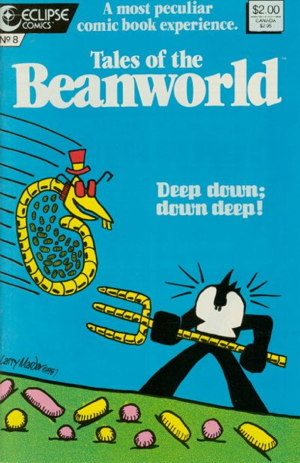 Under most circumstances the phrase “most unique” is, oof, a cringeworthy nonsensical usage. If something is already unique, then it’s by definition one of a kind and unusual, it can’t be more of that. It’s like something is “extra infinite.” However, occasionally exceptions must be allowed, and in this case, I believe referring to Tales of the Beanworld as “the most unique comic ever published” is an allowable description.
Under most circumstances the phrase “most unique” is, oof, a cringeworthy nonsensical usage. If something is already unique, then it’s by definition one of a kind and unusual, it can’t be more of that. It’s like something is “extra infinite.” However, occasionally exceptions must be allowed, and in this case, I believe referring to Tales of the Beanworld as “the most unique comic ever published” is an allowable description.
Where…hmm, where do I even start. There is a page you can look at to give you a general overview of just what Beanworld is (and the comic’s creator, Larry Marder, is pretty good about giving you the background you need to know in each issue and graphic novel. But in short:
The comic takes place primarily on what appears to be a small island, dominated by a large tree (or tree-like being) in its center. It is populated by “beans,” many of whom are identical though occasionally one (or several) will “break out” into a specific personality or type (such as an inventor). They are protected by the non-bean-like hero Mr. Spook, along with his trusty fork (seen in the pic above).
The beans and Mr. Spook live in a cyclic existence with the Hoi-Polloi, beings that live deep beneath the “water” (AKA “the Four Realities”). When the central tree (Gran’Ma’pa) occasionally drops off a piece of itself, the beans, headed by Mr. Spook, must take it to the Hoi-Polloi for them to crush and convert into smaller pellets that they use for gambling, but the beqns use for food. This is a dangerous endeavor that requires the beans to be armed with little spears and such.
This is the very, very basic setting for the comic, and the stories arise from some disruption or change to the status quo of the presented world. What happens with a spider invades the island? What happens when one of the beans “breaks out” and becomes an artist? What happens when new beans arrive? What happens when other things from outside Beanworld arrive (see again the cover above)? As strange as the book may appear, as outside the usual comic book experience as it may be, it is very easy to find yourself involved in the goings-on…
…especially frustrating since the series ran only 21 issues originally, ending in 1993 with sporadic new material afterwards. And sometimes that new material spends a lot of time explaining how Beanworld works again. I know there have been life happenings for Mr. Marder that take precedence over this work, so I’m not complaining, honest. But the story does seem to have an ending in its future, with some tantalizing events hinted at by Marder, so I hope he gets the chance to wrap it up in the way he wishes.
New post-Eclipse material has shown up at Rob Liefeld’s Maximum Press (in the full-color Asylum anthology series), an issue of Myspace Dark Horse Presents, and a color special from Dark Horse. There are also some one-pagers presented in Giant-Size Mini-Comics #1 (Eclipse 1986), some feature beans, some may or may not be tied to Beanworld continuity. Also someone around here in my still-in-disarray comics collection I believe I had one of Marder’s mini-comics, starring the Big Fish, acquired from the man himself at an indie comics con I went to a couple of decades back.
Now, Beanword has been reprinted a few times, including four paperbacks from Eclipse Comics going up to issue #16. In the 2000s, Dark Horse published a series of five hardcovers, the first three reprinting previous Beanworld material, and the last two featuring all new stories. There were also two thick paperback omnibuses, also from Dark Horse, the first reprinting the original 21 issues, and the second containing the later material, including both of the new stories from the last two hardcovers. It may not surprise you to discover that only the volume 4 hardcover is currently available to order from Diamond, while Penguin Random House has both Omnibuses and that fourth hardcover. (Should note that the mini-comic stuff doesn’t appear to be reprinted in these books.)
As I’ve chronicles on this site in the past, the beans have made appearances in other books, with one of them being Totally Canon and part of that character’s development. First, the beans appear in Scout #17. And then, one of the beans, the artist Beanish, ends up part of the “Total Eclipse” crossover event, where he meets up with best pal Miracleman:
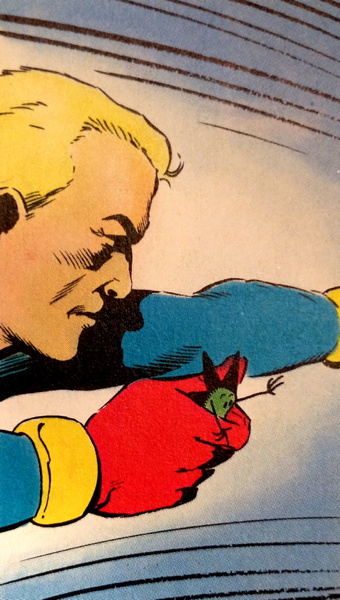
The greatest comics panel ever published? It’s certainly up there.
Should also note that there was a “Munden’s Bar” back-up in Grimjack #42 drawn by Marder (and written by John Ostrander and Del Close), but was not a tie-in, as I recall,
And that’s Tales of the Beanworld for you…certainly one of the best from the ’80s and an old fave of mine as well. But which 1980s title did I actually vote for in this event…hang in there and you’ll find out soon enough!
And we’re back to the “fave ’80s indies” poll with our next entry:
Jon Sable, Freelance (First 1983-1988)
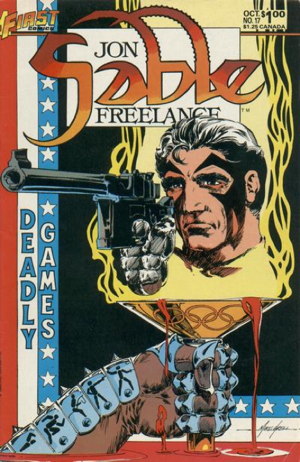 I did read Jon Sable Freelance for a while, starting somewhere in the early issues (not with #1, but around issue #10 or #12 or so) and kept up with it for a couple of years. Near the end there, I was mainly picking it up for my dad, as it was one of the few comics I was buying that he was also reading. I eventually dropped the book, as it was costing me a whole $1.75 a month, and I wasn’t enjoying it quite as much. (At least I was still buying Groo the Wanderer which my dad was also reading.)
I did read Jon Sable Freelance for a while, starting somewhere in the early issues (not with #1, but around issue #10 or #12 or so) and kept up with it for a couple of years. Near the end there, I was mainly picking it up for my dad, as it was one of the few comics I was buying that he was also reading. I eventually dropped the book, as it was costing me a whole $1.75 a month, and I wasn’t enjoying it quite as much. (At least I was still buying Groo the Wanderer which my dad was also reading.)
The series premise was that Jon Sable was a bounty hunter for hire, who had a “secret identity” as a children’s book author named “B.B. Flemm” (complete with a blonde wig and mustache), which was a little peculiar but did give the book that little bit of a twist to make it unique. Mike Grell created the character, wrote the entire initial series, drew all the covers, and illustrated most of it with other artists stepping in during the last dozen or so issues.
A second series started up in 1988, after the first ended, called simiply Sable and primarily written by Marv Wolfman, with art by Bill Jaaska and others. It was accompanied by a TV show adaptation of the property, also called Sable, that came and went with seven episodes in late ’87/early ’88. I never did read any of this second series, despite enjoying Jaaska’s artwork when I’ve encountered it. I also maybe saw a total of about 10 minutes of the TV show, which all things considered was probably about 10 minutes more than most people. Which…you know, it feels like the premise would lend itself to television, but not everything gets traction, y’know.
While the second series was running, First also published Mike’s Grell’s Sable, reprinting the early issues of the original run. The comic was canceled with #10.
Grell would return to the character with a couple of new mini-series from IDW: Bloodtrail in 2005, and Ashes of Eden in 2009. IDW would also release eight volumes of The Complete Jon Sable Freelance, which reprinted up to #45 of the initial run.
Comicmix would later, in the mid-2010s, put out four volumes of the Jon Sable Freelance Omnibus, reprinting all 56 issues of the original run, as well as the two iDW minis. The non-Grell Sable run is skipped entirely, unless some issues of that run are included in Volume 4 (as the original solicit for that volume lists the contents as including “other surprises”). All these reprint volumes appear to be out of print, but hopefully are still easy to find if you’re interested.
Along the way, Jon Sable popped up in the First Comics 988 crossover series, appropriately titled Crossroads, teaming the character with the ninja character Whisper in the first issue. This was by Mike Baron, Angel Medina and Rod Whigham. In 2000 Grell wrote a prose novel called Sable (which you can get for as little as five bucks from Amazon). And in 1996, Grell wrote and drew two issues of Maggie the Cat for Iimage Comics, featuring a recurring character from Jon Sable.
Like I said above, I only read these comics for a couple of years, and not from the beginning, so I can’t pin down a “peak” period of the character for you to sample. I think, though, if you want to give it a try, sticking to the first couple years’ worth of stories may be your best bet, where Grell’s story and art are at their strongest. And they’re fairly cheap, too…I think I have a couple of copies of the first issue at my shop right now, and they shouldn’t be more than two or three bucks apiece. And I’m pretty sure I have more of the series in the endless backstock that I’m always trying to get processed and priced.
I do want to point out one issue of particular note, #33 from 1986, which presents material from one of Sable’s alter-ego’s children’s books. Here we find out “B.B. Flemm” draws an awful lot like Segio Aragones, who provides the art for those segments.
And here’s something I wish I had a scan for to back me up…but sometime in the 1980s, my dad spotted in the classified ad section in the Soldier of Fortune magazine an entry that read something along the lines of
“Need help? Problems solved – Jon Sable Freelance”
…along with a phone number. Okay, I’m not sure of that wording at all, but it was definitely for “Jon Sable Freelance.” I have no idea if that was a joke inserted by an editor who was a fan of the comic and needed to fill space, or if it was an ad placed by First Comics, or possibly Grell himself, with the phone number going to a recorded message plugging the comic or something. A mystery for the ages! Unless someone knows the answer and can tell me.
EDIT: hold the phone, I actually used this new thing called “Google” and found this entry on the Internet Archive, featuring “full text of ‘Soldier of Fortune Magazine.” It’s, like it says, just text, not scans of the pages or anything, but it has the ad:
“JON SABLE, FREELANCE MERC. Covert, efficient, passport, anonymous. Short-term, high pay/risk contracts. Urban work preferred. Fee’s plus expenses. Nothing illegal. Contact:
JON SABLE. [REDACTED], Quebec CANADA
H9S-3J3. (514) [REDACTED]. (101)”
I cut out the address and phone number, but they’re intact over at the link. This appears to be from the February 1986 issue, if I’m reading the info correctly. Anyway, my memory of the ad text was way off, but still I…I don’t know what to make of this. Again, if you folks have answers, let me know!
EDIT: Click here for the follow-up to this post!
Movin’ along the Favorite ’80s Comic Poll list to our first four-vote-getting entry:
Grendel (Comico 1983-1984)
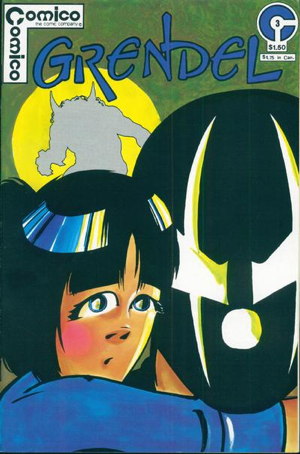 This is another case the listing the first ongoing series featuring the character in the header there is a little misleading as to the size and impact of the property. After first appearing in the second issue of the Comico anthology book Primer in 1982, Matt Wagner’s character launched in what was supposed to be a six-issue series the next year. It was crude and amateurish but had an undenialable energy beneath its striking covers that put it a step above most of the other black and white boom comics of the era.
This is another case the listing the first ongoing series featuring the character in the header there is a little misleading as to the size and impact of the property. After first appearing in the second issue of the Comico anthology book Primer in 1982, Matt Wagner’s character launched in what was supposed to be a six-issue series the next year. It was crude and amateurish but had an undenialable energy beneath its striking covers that put it a step above most of the other black and white boom comics of the era.
The series ended prematurely after three issues. In 1984, Comico started publishing Wagner’s next big project Mage: The Hero Discovered, a full-color urban fantasy adventure. Starting in issue #6 of that series in 1985, and running through #14, Wagner included a serialized Grendel back-up story. This story retold the tale that was intended for that aborted mini, in a more experimental caption-heavy format.
The premise of the Grendel comics, at least at the beginning, can most simply be summed up as “the villain is the hero,” where Grendel, AKA rich socialite Hunter Rose, is a handsome, witty and appealing, while living a secret life as a murderious crime lord. The hero of the story is Argent, a misshappen and grotesque wolf-like being, flipping on its head the usual superhero/supervillain dynamic one would see in comics. It’s not an unusual inversion…I mean, you can’t throw a rock without hitting a Godfather or a Breaking Bad where we’re invested in the bad guys. Even in John Milton’s Paradise Lost, all the good bits involve Satan and all the Heaven stuff is boring.
Now, at the end of that initial story, Hunter Rose is killed, and the next Grendel series launches in 1986. The first 12 issues of that, written by Wagner, illustrated by the Pander Brothers, takes place in the near-future of…sometime around 2010 or so in which the “grandaughter of Grendel” (Christine Spar, the daughter of Hunter Rose’s adopted child) takes on the costumed identity. From there, the idea of “villain as hero” evolves into Grendel being more an examination of violence and aggression as the mantle passes from person to person and the “spirit of Grendel” supposedly influences people and events.
That Grendel series ends with issue #40 in 1990, with the title of Grendel being held by the conqueror of Earth in the 26th century, so clearly the premise had gone through some permuations. Past this, Grendel comics move to Dark Horse Comics with a number of mini-series by various creative teams, either continuing in this future world, or filling in backstory (like a mini featuring the tragic adulthood of Hunter’s adopted daughter Stacy), or a handful of series telling more tales of the original Grendel. Of note are two mini-series pairing up the character with Batman (one with Hunter, the other with Grendel-Prime, a future Grendel who arrives via time-travel). There’s also Gredel Vs. The Shadow in 2014, so long as we’re talking about crossovers.
The most recent series, Grendel: Devil’s Odyssey, ran from 2019 to 2021, written and illustrated by Wagner. To be frank, I gave up briefly on some of the earlier Dark Horse minis set in the far future, as I just didn’t have the interest. I did pick up the later Hunter Rose minis, and that Devil’s Odyssey I have to read eventually, but it started during the height of my eyeball issues so it’s ended up in the “read these later when I can see again” stacks and I haven’t gone back to them yet. It looks good, though!
Now, if you want to read any of this stuff…a lot of it is still available in paperback, primarily through four omnibuses, starting with the Hunter Rose era and working its way through to the future Grendel Prime era. The “Devil by the Deed” story that ran as the back-ups in Mage has been reprinted on its own several times, including an 8 1/2 by 11 inch graphic novel from Comico, and a couple of comic-book sized reprints from Dark Horse. The non-Wagner Grendel material has been reprinted in two Grendel Tales omnibuses, but only the second one appears to be available currently.
The original black and white Grendel stories from Comico, the Primer short and the three released issues of the mini, were collected in Grendel Archives from Dark Horse, but that hardcover appears to be unavailable. Most of the Grendel run has been reprinted in one form or another over the years…I had a paperback at my shop recently that Comico had released in 1988 of the Christine Spar Grendel story, and the story that had followed in the 1986 run, illustrated by Bernie Mireault, had been collected on its own as well. There’s lots of out-of-print books out there, you just have to keep your peepers peeled for them.
Shipping in November of this year is Devil by the Deed Master’s Edition, a brand new retelling of the Hunter Rose story, written and drawn by Wagner. So, there’s more yet to come!
One oddity I hadn’t mentioned was a slim 16 page Grendel comic, Devil’s Vagary, which was included in the Comico Collection slipcase. The slipcase, which is actually a pretty nice item featuring a Grendel design, was a “sampler package” (i.e. Comico trying to clear out the warehouse) of a handful of random back issues, which featured this exclusive Grendel story (written by Wagner, drawn by Dean Motter). I’m sure this story must have been reprinted somewhere, probably in the first Omnibus, but there’s no indication on the comics database page I linked. Maybe someone can let me know.
If you’re new to Grendel and want to try it out, I honestly think you can’t go wrong with any of the Hunter Rose stuff. It’s Basic Grendel, the purest distillation of the concept, and the source from which everything else follows. The 1986 series that begins with Christine Spar and moves on from there is good as well, though as the series progresses further into the future, and the mini-series by Other Hands kick in, the franchise gets a little lost in the weeds, I think. Your Mileage May Vary, as they say.
And I should probably bring up the fact that a live-action Grendel series was pretty much all ready to go on Netflix, until Netflix decided this was the one series they weren’t going to throw at a wall to see if it stuck. Ah well. Hopefully it’ll get out there somewhere.
Back to Ye Olde Favorite ’80s Comicks Polle for our latest entry:
The Tick (New England Comics 1988-1995)
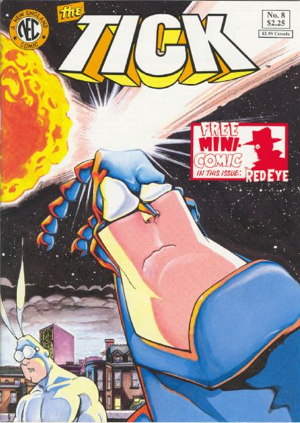 I’m a’gonna get the shameful confession out of the way first. I…never really got into any of the Tick comic books or its many, many spinoffs beyond the initial issues by creator Ben Edlund (those cited in the heading just above).
I’m a’gonna get the shameful confession out of the way first. I…never really got into any of the Tick comic books or its many, many spinoffs beyond the initial issues by creator Ben Edlund (those cited in the heading just above).
I know, I know, don’t yell at me. People loved the Tick, as per my observations as a humble funnybook seller over the decades. Folks didn’t just get one series and skip the others…they bought all Ticks, all the time, as fast and as many as were published. Even recently, after I acquired a giant pile of Tick back issues for the shop, they remain regular sellers. (Wither new Tick comics? More on that in a moment.)
Now, that first Tick series launched around the same time I started working at the local comic book store, and was also attending college. I didn’t start buying it from the beginning, despite the fact 1) I was always looking for new and weird offbeat books, 2) I always checked out the black and white comics for idiosyncratic visions, and 3) I liked comics that were funny.
But it took a college pal, Ray, who also worked just down the street from the comic shop and would buy comics from me occasionally, to turn me onto the book. Just hanging out between glasses one day, Ray asked me if I’d been reading The Tick, and after I said no, he regaled me with a handful of funny bits from the comic…enough so that next time I was at work, I decided to try it out.
And it was a good decision. That first series, under Edlund’s pen, was a wild ride of a superhero parody, starring a mysterious, oversized, “nigh-invulnerable” dude in a blue costume with antennae fighting crime in his own peculiar way. Eventually accompanied by Arthur, his moth-costumed pal who, as far as I remember, only went by “Arthur” as his superhero name.
Tick started as a mascot created by Edlund for the New England Comics store, appearing in newsletters until graduated to its own full-sized comic. (And I mean “full-sized” as it was printed at “Golden Age” size, larger in dimensions than other not-as-funny comics on the stands.) It ended up being enormously popular, with multiple Tick series (Karma Tornado starting during the initial series’ run) following by Many Other Hands. And that’s not counting spin-offs like Paul the Samurai and Man-Eating Cow.
Look, a lot of great people worked on these other non-Edlund comics. I admire the craft and consistency and willingness to just continue keeping Tick on the shelves and in front of people. But…what tickled me about those original Ticks didn’t seem to be in these other releases. Probably a “me” problem, since humor is very subjective. Again, don’t yell at me, please.
Now, if you want to read the Tick…well, nothing is currently being published, and the Tick offerings for recent Free Comic Book Days have even dropped off of late. On the plus side, a lot of Tick comics and trade paperbacks reprinting those comics have been unleashed over the years, so there should be plenty of these out there to track down. The most recently available book, brought back into print on occasion over the last few years, is a trade paperback reprinting the Complete Edlund stories (plus the Psuedo-Edition #13, produced to provide the thirteenth issue Edlund planned but never did).
I didn’t list all the series and reprints and variants and whathaveyou here just because there are so many. My suggestion is try out the Edlund material first, and if you like that, ignore cranky old Mike’s opinions and try out some of the spinoffs, which most people like just fine.
Should also note the media spinoffs, including a well-regarded animated series, a beloved single season of a live action show starring Patrick Warburton, and a couple seasons of a more adult-oriented but still hilarious Amazon Price series starring Peter Serafinowicz. Oddly enough, I loved the live action shows (more the Warburton one than the Amazon one), but I never warmed to the cartoon. Look, I know that makes me a weirdo…the path I follow is not an easy one.
Finally back to the favorite ’80s indies poll, which I put off a bit because…well, I’ll get into it.
Mister X (Vortex 1984-1988)
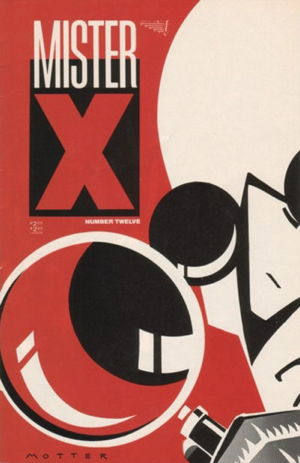
My first exposure to the idea of Mister X came from Amazing Heroes #48, which cover featured the character and contained an extensive preview of the then-forthcoming titles. While the character was created by Dean Motter, who had originally planned to produce a series illustrated by Paul Rivoche, the initial issues of the first Mister X comic were by Jaime, Gilbert and Mario Hernandez.
That issue of Amazing Heroes came out early in my picking up that ‘zine, so I read and reread this issue and thought this Mister X thing sounded interesting. And the Hernandez Bros’ involvement of course caught my attention. Inexplicably, I ended up not buying the comic. I don’t know if I missed it on the shelf, or if I didn’t have the scratch for it (I was 15, long before I had the Infinite Comics Retailer Budget that all comic shop owners have now), but I just didn’t pick it up. And, to this very day, it still remains one of the very few Hernandez blind spots in my funnybook reading. Even now, as an issue from their run shows up at the shop, it’s just, like, a single copy of #3 or something and not a full run, I just go ahead and price and sell it.
Anyway, the Hernandezes left the book after the fourth issue due to some problems with the publisher, and Motter wrote #5 with Ty Templeton (who’d been lettering the book), and the art was by Klaus Schoenefeld (who’d colored the previous issues. Issue #6 through #13 were illustrated by Seth…yes, that Seth of Palookaville fame. The last issue was drawn by Rodney Dunn, which was redrawn by Motter himself when the story was included in a later collection. Motter provided most of the covers for the first series, with others drawn by Bill Sienkiewicz, Dave McKean, and Mike Kaluta.
The premise of the series I still remember form that Amazing Heroes preview (and I double-checked against Wikipedia, to make sure I wasn’t too far off): Mister X is a bald and bespectacled fella who lurks about in the wildly-designed Radiant City, and as allegedly its architect he seeks to maintain the city and deal with any problems that arise within it. He is also dependent on a drug to keep himself awake 24 hours a day. He is a man of mystery to most of the cast, though his girlfriend Mercedes refers to him as “Santos.”
There were more series that followed, including a second one from Vortex (1989-1991, mostly written by Jeffrey Morgan, with art by Shane Oakley and D’Isareli), a four issue series in 1996 from Caliber Press, and then a few mini-series from Dark Horse (2008-2015) as well as appearances in Dark Horse Presents. Also in there was a Mister X Special from Vortex in 1990 by Peter Milligan and Brett Ewins.
So yes, I missed a lot of this as it was happening. I think the only Mister X content I experienced in real time were entries in the A1 anthology from Atomeka (including a story by Neil Gaiman and Dave McKean). And I never got around to these either, but other Dean Motter books that took place in the same “world” were Terminal City (DC/Vertigo 1996-7) and Electropolis (Image 2001-3), both by Motter. Mister X is in the latter…I don’t know if he’s in the former.
Now, if you wanted to read all this stuff now? The only collection currently available from Diamond is Razed, one of the later Dark Horse minis. Otherwise, this may take some searching, but Dark Horse produced two volumes of Mister X Archives, reprinting up to the second Vortex series. Volume 1 appears to have been in both hard and softcover. Volume 2, “Brides of Mister X and Other Stories,” I think was only in hardcover. A third Dark Horse release, Mister X: The Modern Age, reprints all of Dark Horse’s Mister X releases. (All of the Dark Horse minis have had their own trade reprints.)
From iBooks there were two volumes of Mister X: The Definitive Colleciton from iBooks in 2004-5, reprinting up through the second Vortex series plus lots of extra material (from A1 and elsewhere). And for you completists, there were also collections for Terminal City (in HC from Dark Horse) and Electropolis (in trade also from Dark Horse), both out of print.
Now I put off writing this entry because, like I said above, my knowledge of the series is almost exclusively from 1) the Amazing Heroes article, and 2) those segments in A1. Most of what I wrote here was cobbled together from those memories and what I could piece together from the Comics Database and Diamond’s old product catalog. It remains a pretty big gap in my comics reading, especially those early Hernandez Bros. issues. I can still recall a bit of that feeling of experiencing something new in comics when reading that ‘zine article, like when I first read about Cerebus in Comics Scene. But I missed out at the time, and hopefully I can make room in all the comic reading I have left to do to finally redress this omission.
So next up on the ol’ Final ’80s Countdown, the following three-vote getter:
Miracleman (Eclipse Comics 1985-1993)
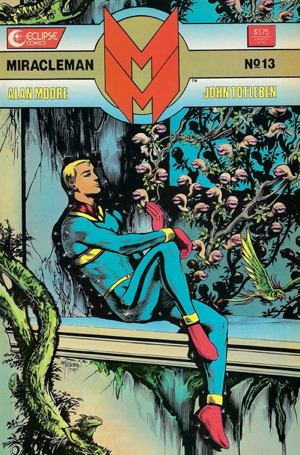 Hoo boy, where do I even start? Well, technically, I’ve started already, as I’ve got a whole category on this very site talking about Miracleman and its long history and hiatus and revival and hiatus again and revival again. Well, talking, and whatever this is.
Hoo boy, where do I even start? Well, technically, I’ve started already, as I’ve got a whole category on this very site talking about Miracleman and its long history and hiatus and revival and hiatus again and revival again. Well, talking, and whatever this is.
Anyway, let me give you a very brief rundown. A British publisher, L. Miller and Son, had rights to publish Captain Marvel (the Shazam! one) stories in the UK, until Fawcett Comics stopped publishing them in the 1950s. However, L. Miller and presumably also the Son were having good sales on these comics, and had Mick Anglo rework the Shazam! Family of characters into the hopefully-lawsuit-avoiding-but-similar Marvelman Family. This revamped series ran though the early 1960s.
In 1982, the character was revived for the British comics anthology magazine Warrior in its first issue. The creative team, Alan Moore and Garry Leach, took an “adult” and “realistic” approach to Marvelman, addressing the clichés and tropes of the superhero genre in a form familiar to anyone who’s read Watchmen and pretty much anything else that was inspired by Marvelman.
Did I say brief? I’m trying, honest. So in 1985 Eclipse Comics got the rights to reprint the Marvelman stories in the U.S., with the minor problem of a little company named Marvel Comics possibly not being amused by another publishr using “Marvel” in a comics title. Hence, the change to “Miracleman,” the name by which the character has been known ’round the colonies ever since. (With a few exceptions, I’ll tell you in a moment.)
That run from Eclipse was 24 issues, which reprinted nearly all from Warrior magazine (save for one short story) by Leach and Alan Davis. That was followed with new material, illustrated by Chuck Austen, Rick Veitch, and John Totleben. Moore departs with #16, and the remainder of the run is by Neil Gaiman and Mark Buckingham.
And then Eclipse went out of business and Miracleman went into limbo and there all sorts of questions of who owned what (with Todd McFarlane believing he owned the character at one point, and attempted to integrate the character into his Spawn comics as well as releasing some limited merchandise).
Eventually things get as straightened oout as they’ll ever be, and Marvel, ironically enough I suppose, now owns the rights to the character. They kicked off their reign with reprints of original Marvelman material from the ’50s, before launching into reprints of the Eclipse run. The promise was that after the reprints concluded, Gaiman and Buckingham would be back to continue the story. Well, technically they did, I suppose, though the reprints ended in 2016 and the new Miracleman stories would not appear until very late in 2022.
Now don’t shout at me if I missed anything…I’m sure I left a bit out of the character’s compliated publishing path. The Wikipedia entry gives a more complete overview (though it notes complaints about the “birth issue” were mainly in fanzines, without noting a particular distributor was certainly not pleased about it).
There was also a mini-series Eclipse released called Miracleman Family, reprinting ’50s material, as well as Miracleman: Apocrypha, a three-issue mini featuring new short stories by various creators. Eclipse also released the Miracleman 3D one-shot, reprinting the UK Marvelman Special, which was a new Moore/Davis framing sequence around more ’50s Marvelman reprints.
Marvel also had some extra material outside the main story, once it got its mitts on the property, with a couple of annuals, Apocrypha-style, with new stories by other creators.
And one should also probably note, once Gaiman and Buckingham were back doing new issues, Buckingham went back and redrew the previous two issues with parts one and two of “The Silver Age” before moving on to the never-before seen story in #3.
Granted, it’s been a little bit since the latest issue of the new Miracleman comics (last one released early May), but at least something has come out after such a long drought. I mean, how many comic book series have had a hiatus of nearly three decades and come back with the same creative team? Not a whole lot, I’m guessing.
Now, what’s the best way to read all this mess? With the Eclipse comics, I’d say…the original comics is the best way, if you can get your hands on them. Or the trade paperbacks released by Eclipse, which I believe reprint through issue #22. There is an Apocrypha trade as well. The problem with any of these options is that they can be a bit on the pricy side. Even Apocrypha is slowly getting up there, after years of being a cheapie (and not yet having been reprinted by Marvel, near as I can tell).
Best bet for an “affordable” version…Marvel had individual collections for the material, which in typical Marvel form are all out of print (save for a volume reprinting all of “The Golden Age” segment, Gaiman and Buckingham’s opening chapters, plus a back-up from Total Eclipse). There is a Miracleman Omnibus with all the material prior to that, including a “Warpsmith” story from the A1 anthology.
If you’re going to read the comic book versions of Marvel’s reprints, keep in mind that Miracleman #14 (2005) had a drastic printing error that Marvel never bothered to fix in the periodical format, but hopefully got right in its trades.
For sampling the earlier material released in England, try the Marvel Tales: Miracleman which includes stuff from Warrior, among other sources.
Okay, I talked a lot about where you can read it and how it came out, but is it all worth it? I would say…yes, yes indeed. It was going the superhero “deconstruction” thing back when it was still a fresh idea, and it’s filled with wonderful and bizarre concepts and new takes on an old genre. (It should be noted that it’s been said that the novel Superfolks has had a strong influence on this series, and other works of Moore’s.) It blew my mind as a young Mikester, and it definitely helped steer where things were going in the comics industry at the time.
I shouldn’t let pass the fact that Marvel, despite being, you know, in charge of the Marvel brand (well, okay, Disney actually is, but go with me here), still kept the name “Miracleman” on the revived series. I suspect very much it’s to keep the very not-Marvel-House-Style-y version of the character as its own separate thing, leaving the company free to introduce its own separate version of the character into the Marvel Universe proper with the less-burdened moniker of “Marvelman.” This feels like what’s going on with the DC Rebirth one-shot-esque revelation at the end of this State of the Marvel Universe special Timeless that M(something)man is going to pop up eventually.
Now I’ve joked that this particular revelation could point at the fact that, following “The Golden Age” and “The Silver Age” Miracleman chapters, we could get from Gaiman and Buckingham “The Marvel Age,” with MM fighting Galactus or Stilt-Man or whoever. If this were the case, I would find myself in the very peculiar state of being simultaneously extremely pissed off and supremely delighted.
But no, I’m guessing we’re getting a Marvelman event in the Marvel Universe entirely aside from the Miraclman thing. Which leaves us with the question of which name will they use for the eventual Marvel movie that will underperform?
I’m getting off-track here. Miracleman was a great comic that I think holds up even today. It’s very early Alan Moore, with some clunky writing at times, but still exciting and compelling. And Gaiman and Buckingham’s follow-up material, picking up from a very definitive conclusion by Moore and Totleben, remains wondrous and fascinating. If you were turned off from reading the series because of Marvel’s initial terrible handling of the material (with overpriced comics stuffed with unwanted material padding out the few pages of interest), give the collected books a go.
(And I didn’t mention it, but you guys probably will if I dont, but Moore had his name removed from Marvel’s reprints, and it was replaced with “The Original Writer.” And lo, there was much frivolity when this was revealed. Look, Moore’s not a big man of Marvel, he could have said “no” to having his stuff reprinted at all, so I’m just glad the material’s available in the first place.)
Back to the fave ’80s titles survey, with the next three-vote getter:
Mage (The Hero Discovered) (Comico 1984-1986)
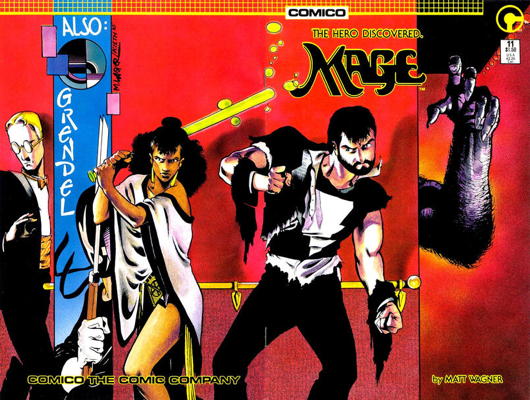
In 1983 we saw writer/artist Matt Wagner’s Grendel, which had its run cut short at three issues. The covers were quite striking, Wagner’s then-amateurish-but-charming art assisted by subdued coloring. The interiors were simplistic and, to a certain extent, crude, but clearly promise was there and the story (of our title character, a glamorous villain, pit against a not-so-pretty hero) remained compelling. But with the story half-completed in this format, we didn’t get a chance to see Wagner learn on the job, improving his artwork and storytelling skills as we watched.
Not so with Mage (subtitled “The Hero Discovered” on the cover), as we can clearly watch Wagner’s evolution as a comics creator over the course of this 15-issue series (helped in no small part by inker Sam Kieth, who comes on midway through the run). Looking at the first issue compared to the last…well, I’m not going to say it’s like looking at two different artists, because clearly you can see the line from one artistic state of being to the other, but there certainly is a notable refinement in form.
The story is…well, our hero, the surely-by-coincidence-looking-like-his-creator Kevin Matchstick is called upon by Mirth (the titular Mage) to protect the Fisher King from the Grackleflints, spawn of the evil Umbra Sprite, and whatever mystical menaces they unleash. In this Kevin is assisted by Sean (a ghost) and the streetwise Edsel.
…Yeah, that’s a bit, but it all works in context, I promise.
The story continues in Mage (The Hero Defined) published by Image from 1997 to 1999 (including a #0 issue you had to mail away for), and concludes in Mage: The Hero Denied from 2017 to 2019 (also from Image, also with a #0 issue that, this time, you could buy in stores). The second series deals with Kevin working alongside other mythical heroes, and the third series has him as a husband and father once again called into battle against mystical evils.
The best way to read this first series however, aside from collecting the original issues (which shouldn’t be too hard at this point) is to get the Donning reprint volumes released in 1987-8. These are oversized, printed on nice, slick paper, and even include the Mage back-ups from the second Grendel series. Comico also published a thing called Magebook that reprinted four issues in each of the (far as I can tell) two volumes released. I think these may have been rebound copies of the actual issues, I’m not sure. I also seem to recall they weren’t…terribly sturdy, but maybe someone can chime in and let me know.
There was an 8-issue series from Image reprinting “The Hero Discovered” in the late ’90s, but…mmm, I’d probably avoid that one. As I understand (and correct me if I’m wrong) due to Wagner no longer having the original art or the film shot from that art, current reprints of this story are sourced from actual printed copies of the original Comico comics. And for this series, the art was relettered and some digital effects applied to some of the artwork, and…it wasn’t great, as I recall. I believe there were several typos in the relettering, and the added effects were very much of the “because we can do them” variety. I don’t know, maybe those effects were covering up defects caused by the less-than-ideal method of obtaining the artwork, but they certainly didn’t appeal to my eye.
As of right now, more or less, all three series have been reprinted in a series of paperbacks, or three hardcovers, from Image (with the typos hopefully fixed in the first series, but the digital fiddling is likely still present). Checking with Diamond’s current stock even as I type this, they have the hardcovers for the first two series and one of the two books reprinting the last series. (EDIT: my mistake, a third hardcover reprinting Denied appears to have never been released.)
Again, ideally, just get the original comics if you can. It’s good stuff all the way through, you get the letters pages, and in that first series you get the Grendel back-ups (telling the full story that was never finished in that 1983 comic). Oh, and you have to get Grendel (2nd series) #16-#19 for the Mage “Interlude” back-ups.
However you get it, it’s a fun read, and it’s hard to believe, looking at the dates, that I read all of these series as they came out, and waited patiently over the literal decade between each one. It was weird, to age along with Mage. Well, Kevin, but that didn’t rhyme.
Anyway, as I’ve said half-jokingly before, I’m still awaiting the fourth series, “The Hero Disco-Dances.” C’MON, WAGNER
As an added bonus, here’s a post from about a year and a half ago with an old piece of Mage promotional material.
« Older Entries
 For over forty years, the Hernandez Brothers (Jaime, Gilbert, and occasionally Mario) have been gifting the comics world with some of the best cartooning and most realized worlds and characters to have ever graced the medium. It’s hard to believe it’s been that long, as you look at the work being produced and you can see no decline, no lessening of their powers — only an ever-continuing evolution and refinement of their craft. The stories remain as entertaining and compelling as they ever were, the artwork perfectly expressive. Every new comic from them is a master class in How To Do Comics and we are lucky to get them.
For over forty years, the Hernandez Brothers (Jaime, Gilbert, and occasionally Mario) have been gifting the comics world with some of the best cartooning and most realized worlds and characters to have ever graced the medium. It’s hard to believe it’s been that long, as you look at the work being produced and you can see no decline, no lessening of their powers — only an ever-continuing evolution and refinement of their craft. The stories remain as entertaining and compelling as they ever were, the artwork perfectly expressive. Every new comic from them is a master class in How To Do Comics and we are lucky to get them. 

 Well, this will be a tricky entry since I spent a
Well, this will be a tricky entry since I spent a 
 Grimjack, the soldier/detective/bounty-hunter/bodyguard/etc. for hire who operates in the multi-dimensional city of Cynosure, first appeared as a back-up story by creators John Ostrander and Tim Truman in Starslayer #10 in 1983. After a run of stories there (capping off with an issue-length crossover with the titular Starslayer his own self), Grimjack moved over to his own first issue in 1984, running 81 issues (and a graphic novel) through ’til 1991.
Grimjack, the soldier/detective/bounty-hunter/bodyguard/etc. for hire who operates in the multi-dimensional city of Cynosure, first appeared as a back-up story by creators John Ostrander and Tim Truman in Starslayer #10 in 1983. After a run of stories there (capping off with an issue-length crossover with the titular Starslayer his own self), Grimjack moved over to his own first issue in 1984, running 81 issues (and a graphic novel) through ’til 1991. 
 Under most circumstances the phrase “most unique” is, oof, a cringeworthy nonsensical usage. If something is already unique, then it’s by definition one of a kind and unusual, it can’t be more of that. It’s like something is “extra infinite.” However, occasionally exceptions must be allowed, and in this case, I believe referring to Tales of the Beanworld as “the most unique comic ever published” is an allowable description.
Under most circumstances the phrase “most unique” is, oof, a cringeworthy nonsensical usage. If something is already unique, then it’s by definition one of a kind and unusual, it can’t be more of that. It’s like something is “extra infinite.” However, occasionally exceptions must be allowed, and in this case, I believe referring to Tales of the Beanworld as “the most unique comic ever published” is an allowable description. 
 I did read Jon Sable Freelance for a while, starting somewhere in the early issues (not with #1, but around issue #10 or #12 or so) and kept up with it for a couple of years. Near the end there, I was mainly picking it up for my dad, as it was one of the few comics I was buying that he was also reading. I eventually dropped the book, as it was costing me a whole $1.75 a month, and I wasn’t enjoying it quite as much. (At least I was still buying Groo the Wanderer which my dad was also reading.)
I did read Jon Sable Freelance for a while, starting somewhere in the early issues (not with #1, but around issue #10 or #12 or so) and kept up with it for a couple of years. Near the end there, I was mainly picking it up for my dad, as it was one of the few comics I was buying that he was also reading. I eventually dropped the book, as it was costing me a whole $1.75 a month, and I wasn’t enjoying it quite as much. (At least I was still buying Groo the Wanderer which my dad was also reading.) This is another case the listing the first ongoing series featuring the character in the header there is a little misleading as to the size and impact of the property. After first appearing in the
This is another case the listing the first ongoing series featuring the character in the header there is a little misleading as to the size and impact of the property. After first appearing in the  I’m a’gonna get the shameful confession out of the way first. I…never really got into any of the Tick comic books or its many, many spinoffs beyond the initial issues by creator Ben Edlund (those cited in the heading just above).
I’m a’gonna get the shameful confession out of the way first. I…never really got into any of the Tick comic books or its many, many spinoffs beyond the initial issues by creator Ben Edlund (those cited in the heading just above). 
 Hoo boy, where do I even start? Well, technically, I’ve started already, as I’ve got a
Hoo boy, where do I even start? Well, technically, I’ve started already, as I’ve got a 







